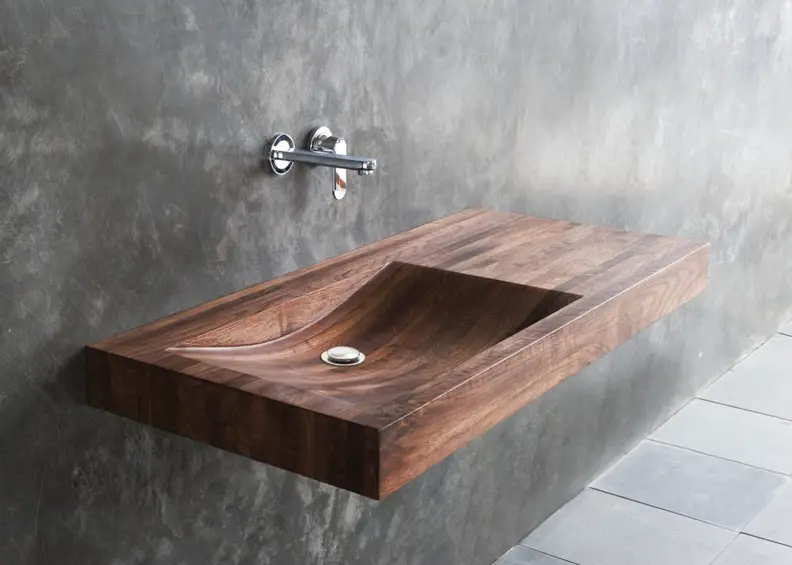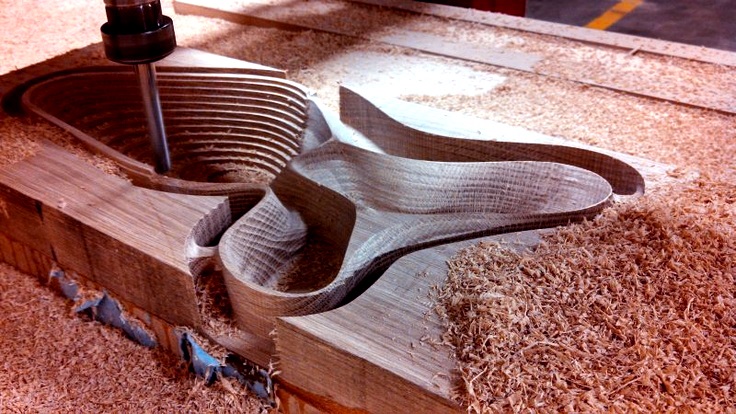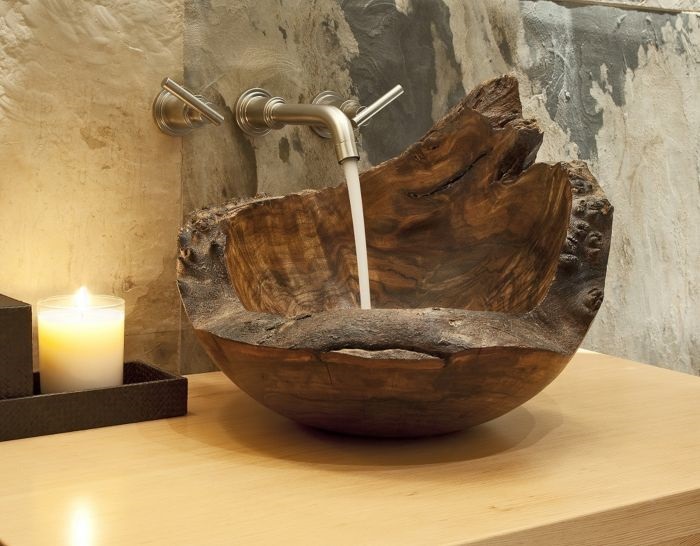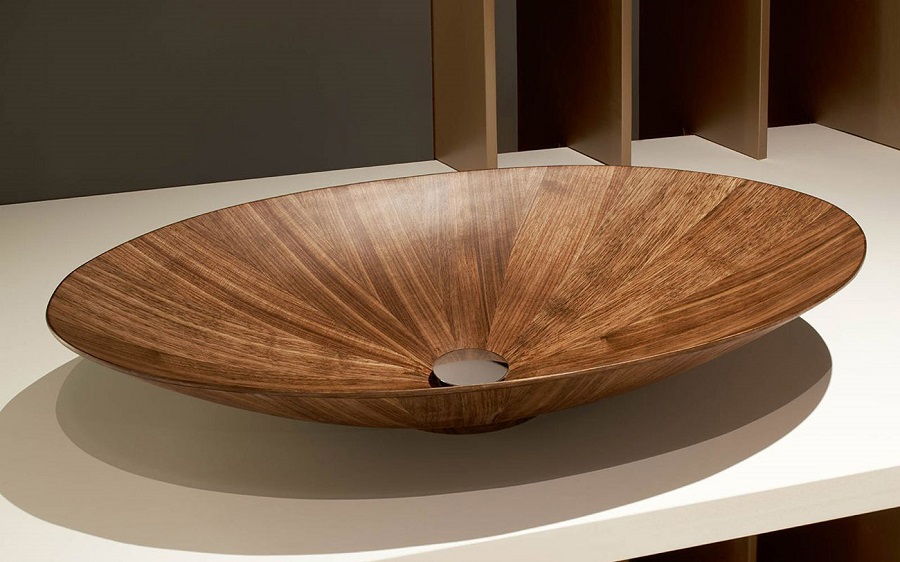A wooden sink in the bathroom doesn't seem like an option at first glance. Wood is poorly resistant to moisture, it molds, it rots, so it would be the last material to consider for an environment that is not even remotely water-free. And yet! Our grandparents used to wash in wooden washstands, water was carried to the fields in a wooden coffin, the well was made of wood, the barrels in which the water or wine was kept were also made of wood. So why wouldn't wood be good for the sink? These are different times and we want wood to look good, not to deteriorate. And precisely because these are different times, there are protective materials that make it possible to protect and maintain wood. And a wooden sink no longer seems incompatible with the bathroom.
Wood used
All sources say wood should be as waterproof as possible. Sinks in teakFor example, they are so tough that they don't even need protecting. The oils that teak has naturally do not allow water to penetrate and so the sink is protected. When you consider that in the old days steamers and boats were built from oak, we conclude that it is also a waterproof material. For sinks, however, it needs to be protected because it has large pores which are a way in which moisture is exchanged. That's true, oak barrels for wine they are not protected with anything, but when left empty, the staves dry out and gaps appear between them (which is something you don't want to happen with a sink). To be watertight again, the barrel needs to be kept with water for a few days. Elm, chestnut, ash are other species resistant to humidity (and outdoors)and can be used successfully in sinks. Exotic species, which are very hard and rich in oils, are also very resistant. In the case of exotic woods, the choice should be made with caution. These species contain dangerous substances and if the sink is finished with oil, it is possible that they may end up in the wash water. Walnut wood is often used for its great looks. It needs to be protected with water-resistant varnishes (we'll get to that in a moment) because its pores are even larger than oak.

Wood gluing and processing
There are a few real artists who make spectacular sinks from a single piece of solid wood. Most, however, make them from panels or glued beams because the wood is more stable and the work surface larger. The adhesive used to make these wood derivatives must have a very good moisture resistance (D4). Also, the wood must be dry appropriate. Wood is worked by carving, turning or milling. A rustic sink looks much better if it is carved, as is still done today. It's true that carved cups and lids are made of poplar woodIt is easy to carve because it is soft and loose. A hard wood is harder to work, but stronger and safer for such use. On the strug you get round, bowl-like sinks. The craftsman has to be a real specialist to make a sink that is both sturdy and delicate. When he finds the perfect balance between the thickness of the wall and its strength, elegant sinks can be created that can be placed in the most sophisticated bathrooms. Another machining method is milling and when done with CNCEverything can be calculated and programmed to produce some of the most spectacular designs.

What treatments to make them as water-resistant as possible
Water protection can be done in two ways, by uleiere and by varnishing. The wood must first be sanded very well so that the surface is very smooth and the absorption controlled. For oiling it is recommended to use mineral oil. It is also used to finish wooden bowls or choppers used in the kitchen. You can also use natural oils, but only for bathroom sinks and only if they do not contain substances harmful to the body. Apply several coats, with absorption and drying time, so that the wood is very well protected. The application is done both outside and inside the sink so that there is no possibility of water getting into the wood. The drain hole is also oiled even if that is where the drain will be fitted. Apply oil until the wood is saturated and no longer absorbing. Wipe off excess and allow to dry for a few days before use. An oiled wooden sink should be maintained. Water will "wash" the oil off the surface over time, so it needs to be refreshed. Depending on how often and intensively it is used, the sink should be re-oiled every 3-6 months. It should be mounted on a stand so that there is no possibility of it standing in water permanently. Over time, in that area, oil will be washed away and mold is likely to develop.

Protection by varnishing
The most used method of protection is with epoxy resin and polyurethane varnish. Epoxy resin is applied in several coats to seal the wood perfectly. In large pore wood (walnut), the resin needs to "wet" the pore when it is poured in order to seal it very well. If it does not go into the pore and remains on the surface, over time the finish coat may "fall" into the pores and if it is also thin, it will crack and no longer provide the necessary protection. Application can be done by brushing, spraying or casting. As I said, apply several coats for a better seal. If air bubbles remain in the film they can be removed by heating the surface of the film with a torch. In between coats, sand and dust off. Finally apply polyurethane varnish. I have seen that most manufacturers use this method of finishing, the number of coats applied, however, can differ from manufacturer to manufacturer. Some can go up to 10 consecutive coats. Polyurethane lacquer coats are between 2 and 5. It is a good idea to check with the varnish manufacturer the number of coats that can be applied to avoid the risk of the varnish cracking. Whichever method is used, it is important that the wood is very well coated, both inside and outside, so that there is no possibility of moisture exchange with the outside.
Where is best to use
Wooden sinks, especially those finished with resin and varnish, should only be used in bathrooms. In the kitchen, their use is risky because knives, forks or aggressive cleaning materials can damage the finish. Wooden sinks are a popular decorative element in hotels, restaurant or business washrooms. They can be rustic, elegant or futuristic. It's all about the design of the sink and how it's finished. And while elegant sinks can be finished in a variety of ways, a sink with rustic look It should have as discreet a finish as possible. If you can't use oil, by no means consider a gloss varnish.





































Add comment